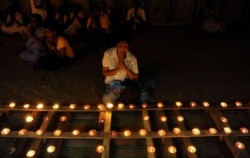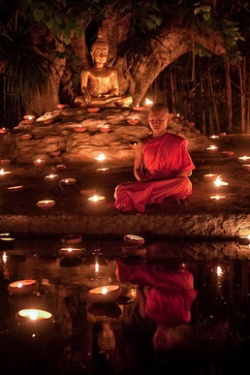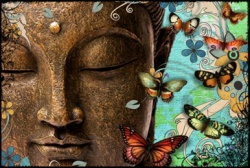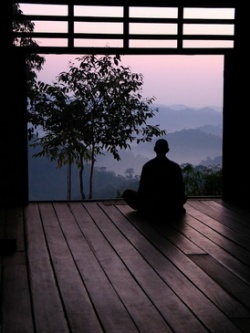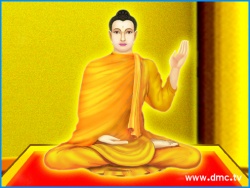Mahāyāna Ethics
The Yogācārabhūmi Śāstra is a notable Indian Buddhist text composed around 300 and 350 CE. It was translated into Chinese by Xuanzang 玄奘 (602-664) in the mid seventh century. It became influential throughout East Asia. There it is attributed to Maitreya while in Tibet to Asaṅga. After Xuanzang translated it, it entered widespread circulation and many scholars drew ideas from it. It is a comprehensive and quite extensive text covering a vast amount of material. Its philosophy aside, the flexible ethics it suggests a Bodhisattva might employ to various ends is something the text is noteworthy for.
I first encountered this when reading a commentary on the Bodhisattva Precepts by the Huayan Patriarch Fazang 法藏 (643–712) who cited the Yogācārabhūmi Śāstra when discussing the special exceptions that might be made when judging whether or not a precept had been violated. This is perhaps where he found most justification for his own willingness to compromise under certain conditions such as suggesting a state could possess Weapons to tame rambunctious beings (he was referring to the state quashing rebellions).
Bodhisattva Precepts are flexible. If it is to benefit beings or liberate them from Suffering a lot of otherwise wrong deeds are not only permitted, they are said to be meritorious. This line of Thought can be seen in earlier scriptures like the Vimalakīrti Sūtra where the layman Vimalakīrti is said to frequent casinos and other disreputable locations in his benevolent quest to aid beings, all the while wearing ornaments and living with a family which was completely contrary to prescribed śrāvaka conduct (i.e., the Vinaya), yet he is still portrayed throughout the text as superior to all the śrāvaka disciples.
He lived at home, but remained aloof from the realm of desire, the realm of pure matter, and the immaterial realm. He had a son, a wife, and female attendants, yet always maintained continence. He appeared to be surrounded by servants, yet lived in solitude. He appeared to be adorned with ornaments, yet always was endowed with the auspicious signs and marks. He seemed to eat and drink, yet always took nourishment from the taste of Meditation. He made his appearance at the fields of sports and in the casinos, but his aim was always to mature those people who were attached to games and Gambling. He visited the fashionable heterodox teachers, yet always kept unswerving loyalty to The Buddha.1
The common idea of these two Mahāyāna texts is that outward Appearances and the letter of the proscription might be provisionally dismissed if it is to benefit beings. This kind of sentiment might have been something of a reaction against rigid advocates of an early Vinaya-based monastic system insisting on decorum and following the letter of the Vinaya proscriptions with various punitive ecclesiastical measures enforced against those who would waver. It seems that the formal Vinaya systems (early Buddhist schools all had their own unique edition) came to exist around the same time the early Mahāyāna scriptures were appearing such as the Vimalakīrti Sūtra. Johannes Bronkhorst in his work Buddhism Under the Shadow of Brahmanism quotes Gregory Schopen on the timing of the appearance of Vinaya literature:
I agree with Gregory Schopen (2006: 316; 2007: 61) that this strange state of affairs may mean that Aśoka [304-232 BCE] did not know anything about buddhist Monasteries, which indeed may not yet have existed at that time. We know that Buddhism started off as a group of mendicants, and Aśoka’s inscription counts as evidence that this group was still not in a position to receive collective gifts at his time.
...
Schopen (2006: 317): “If the compilers of the various Vinayas considered it ‘highly important’ to regulate the lives of their Monks so as to give no cause for complaint to the laity, and if considerations of this sort could only have assumed high importance after buddhist groups had permanently settled down, then, since the latter almost certainly did not occur until well after Aśoka, it would be obvious that all the Vinayas that we have are late, precisely as both Wassilieff and Lévi have suggested a hundred years ago.”
Furthermore...
Schopen, 2007: 61: “Even in the later inscriptions from Bharhut and Sanchi there are no references to vihāras, and they begin to appear—though still rarely—only in Kharosṭḥī records of a little before and a little after the Common Era, about the same time that the first indications of permanent monastic residential quarters begin to appear in the archaeological record for the Northwest, and this is not likely to be mere coincidence.” Buddhist literature also preserves traces of an opposition between Monks who lived in Monasteries and those who lived in the wild; see Freiberger, 2006. Ray (1994: 399 ff.) suggests that buddhist monasticism arose in emulation of the rival brahmanical tradition; both shared two central preoccupations: a concern for behavioral purity and a preoccupation with the Mastery of authoritative religious texts.2
Bear in Mind that the Vimalakīrti Sūtra dates at the latest from the second century CE, which means quite possibly it would have appeared sometime around or shortly after vihāras and monastic residential quarters also started appearing. Given the sometimes humorous portrayal of bhikṣus being overly attached to Vinaya rules (such as Śāriputra complaining to the goddess that being covered in the Flowers she showered him in was inappropriate for a Monk) we might assume such Mahāyāna literature was reacting against the rigid Vinaya institutions that were being formulated around the same time.
A few centuries later such ideas of compromise and Flexibility for greater purposes had been distilled into an acceptable and readily announced Form which we see in the Yogācārabhūmi Śāstra. Take for example the following which deals with how a lay Bodhisattva (non-monastic) might exercise upaya by taking in and coupling with a female.
《瑜伽師地論》卷41〈10戒 品〉:「如菩薩處在居家。見有母邑現無繫屬習婬欲法繼心菩薩求非梵行。菩薩見已作意思惟。勿令心恚多生非福。若隨其欲便得自在。方便安處令種善根。亦當令 其捨不善業。住慈愍心行非梵行。雖習如是穢染之法。而無所犯多生功德。出家菩薩為護聲聞聖所教誡令不壞滅。一切不應行非梵行。」(CBETA, T30, no. 1579, p. 517, c4-11)
“If a Bodhisattva resides as a Householder and there appears a woman who is clearly unbound to anyone, habituated to sexual indulgence, attracted to the Bodhisattva and seeking sexual activities, the Bodhisattva having seen this thinks, 'Do not make her Mind upset, producing much misfortune. If she pursues her desire, she will obtain freedom. As expedient means (upaya) I will take her in and have her plant the roots for Virtue, also having her abandon unwholesome Karma. I will engage in impure activities [abrahma-carya] with a compassionate Mind.' Even practising such defiled activities like this, there is nothing that is violated (precepts), and much Merit will be produced. The renunciate Bodhisattva [a monk) in order to protect the Noble śrāvaka proscriptions must not destroy [their precepts). They should not engage in any impure activities.”
This provides a canonical basis for later developments where eccentric, albeit perhaps controversial deeds, would be appreciated despite the letter of the law stating otherwise. This extends into the very serious matter of taking Life as well, which brings to Mind questions of Buddhist ethics in extenuating circumstances. The hypothetical question of can you take a Life out of Compassion and not suffer karmic recompense for the act? According to the Yogācārabhūmi Śāstra it is possible:
《瑜伽師地論》卷41〈10戒 品〉:「如菩薩見劫盜賊為貪財故欲殺多生。或復欲害大德聲聞獨覺菩薩。或復欲造多無間業。見是事已發心思惟。我若斷彼惡眾生命墮那落迦。如其不斷。無間業 成當受大苦。我寧殺彼墮那落迦。終不令其受無間苦。如是菩薩意樂思惟。於彼眾生或以善心或無記心。知此事已為當來故深生慚愧。以憐愍心而斷彼命。由是因緣 於菩薩戒無所違犯。生多功德。」(CBETA, T30, no. 1579, p. 517, b8-17)
“If the Bodhisattva sees a thief about to kill many beings out of a Craving for Wealth, or about to harm a Venerable śrāvaka, Pratyekabuddha or Bodhisattva, or about to create much Karma [for which he will be reborn in] Avīci Hell, seeing such things he thinks, 'If I sever that Evil being's Life I will fall into Hell (naraka). If it not be severed, then the Karma [for which he will be reborn in] Avīci Hell will see him undergo much Suffering. I should kill him and fall into Hell rather than ever allow him to undergo the Suffering of Avīci Hell.' Like this the Bodhisattva makes an aspiration and thinks, 'I will have a virtuous or neutral Mind towards the being.' Knowing in the future what is to come he thus generates deep shame and with a compassionate Mind severs the Life [of the thief]. It is due to these causes and conditions that there is no violation of the Bodhisattva Precepts, and much Merit is produced.”
We see here that killing in extenuating circumstances and motivated by Compassion is actually condoned. This of course begs the question whether ordinary people are capable of such acts without any Thought of malice, but nevertheless the text states it is possible for a Bodhisattva. If someone was about to slay an Arhat, one of the transgressions for which one is reborn in Avīci Hell, then according to the text it would be virtuous to kill them before they committed the act as it would save them from immeasurable Suffering. At the same time one is aware that one will be reborn in Hell for having killed a being, but nevertheless carries on. This would not constitute any violation of the precept against killing and presumably the Bodhisattva does not fall into Hell, but instead generates much Merit.
The text likewise suggests exceptions to other precepts under certain circumstances. For example, it is permissible to steal back something stolen from The Sangha or a stūpa. Divisive speech is likewise permitted if it is separate someone away from “Evil friends”. Harsh speech is also allowed as necessary.
These ideas I imagine influenced later generations in rather profound ways. For instance, in the Chinese Chan school they developed a kind of ideal master who beats and scolds his disciples for their own good while they may not immediately realize it. Master Linji was perhaps the foremost figure embodying that ideal. Employing violence (such as whacking students with a cane or as some literature relates even breaking limbs or severing fingers) for ultimately benevolent purposes was, at least on paper, acceptable.
We also see the same principle employed in Tibetan literature with the famous example of Milarepa and his master Marpa. Milarepa suffered many trials and tribulations under his nominally abusive Guru, though in the end it was really for his own good and the end result was Milarepa's Liberation. On the surface Marpa might have appeared as an abusive husband with little sympathy for Milarepa, but in reality he provided precious training which enabled his Disciple to overcome his past Karma and fulfil his path as a yogi.
Mahāyāna ethics from the beginning seem to have been quite flexible and as the centuries rolled on perhaps became even more so. I suspect early on that it was in part a reaction against rigid interpretations of the Vinaya where the letter of the law was clearly being favoured rather than its spirit out of institutional concerns.
The Vimalakīrti Sūtra actually blatantly makes fun of such an attitude and clearly some people at the time felt no qualms with such mockery. This possibly also reveals something about the character of the Vinaya as it developed in that if The Buddha himself had felt as strongly about formal precepts and punitive discipline as the Vinaya literature suggests, early Mahāyāna proponents probably would have lacked the ideological authority to basically mock the Vinaya as it would have been tantamount to mocking The Buddha. However, they clearly did feel justified in mocking rigid interpretations of the Vinaya. At that point it is possible the Vinaya literature was not so fully developed and canonical (i.e., ascribed to The Buddha), so much of it was open game for Criticism.
In later times, though, it seems strict Vinaya formalities became quite mainstream, at least among conventional monastics in India and the greater Indosphere. When Yijing 義淨 (635-713) travelled abroad throughout what is now Indonesia and India between 671 and 695 CE he was quite impressed with the strict level of observances the monastics upheld and even wrote a whole book about it.
The Vinaya commentary literature from India that exists in Classical Chinese translation is vast and very detailed. It reads like legal proceedings and makes Judgement calls on fine details. At least in some schools, especially the Sarvāstivāda, they clearly took the Vinaya quite seriously.
Nevertheless, in the late period of Indian Buddhism we see Tantra develop which came to have consort practices and other iconoclastic practices such as eating foul and forbidden substances. The practitioners at the time would have been aware it was not in accord with the conventional Vinaya for monastics and to a lesser extent for lay people as well (which begs the question if Tantra developed outside of Monasteries initially). Here we perhaps see the utmost extreme Flexibility being employed in the context of Mahāyāna ethics and observances, the roots of such iconoclastic practices perhaps traced back to the early Mahāyāna's reaction to strict prescriptions of discipline.
In our present day this all of course has had influences for better or worse, which I hope to discuss in a later post.
